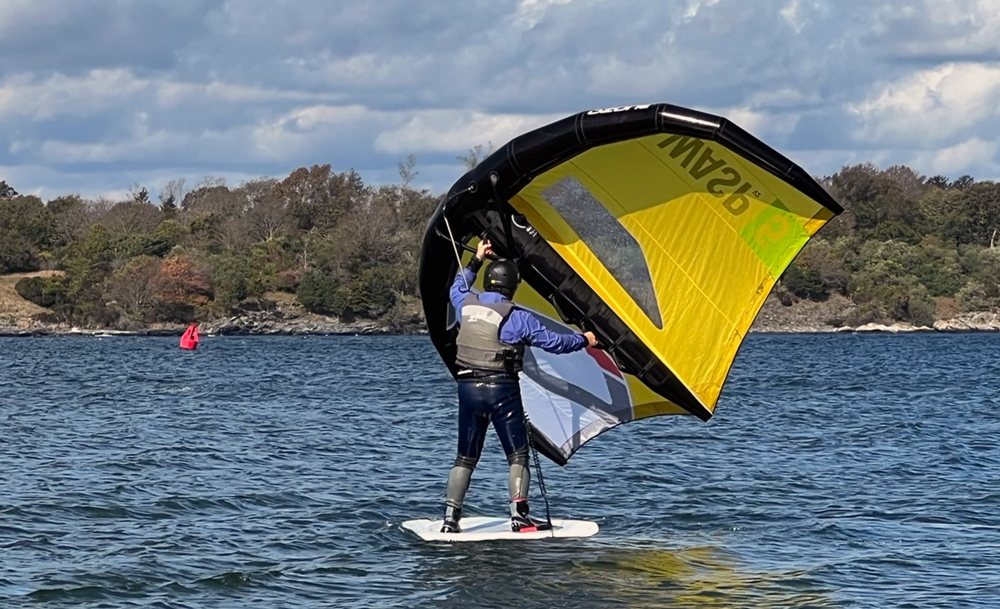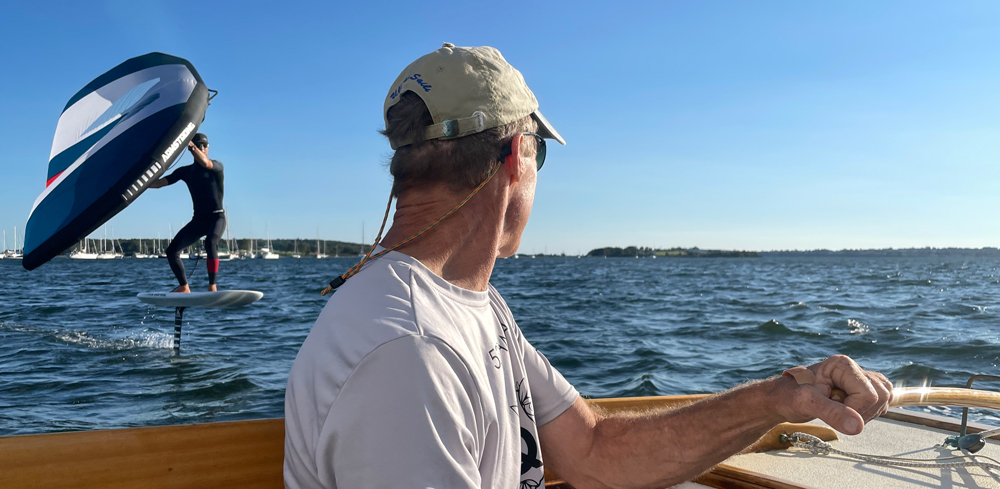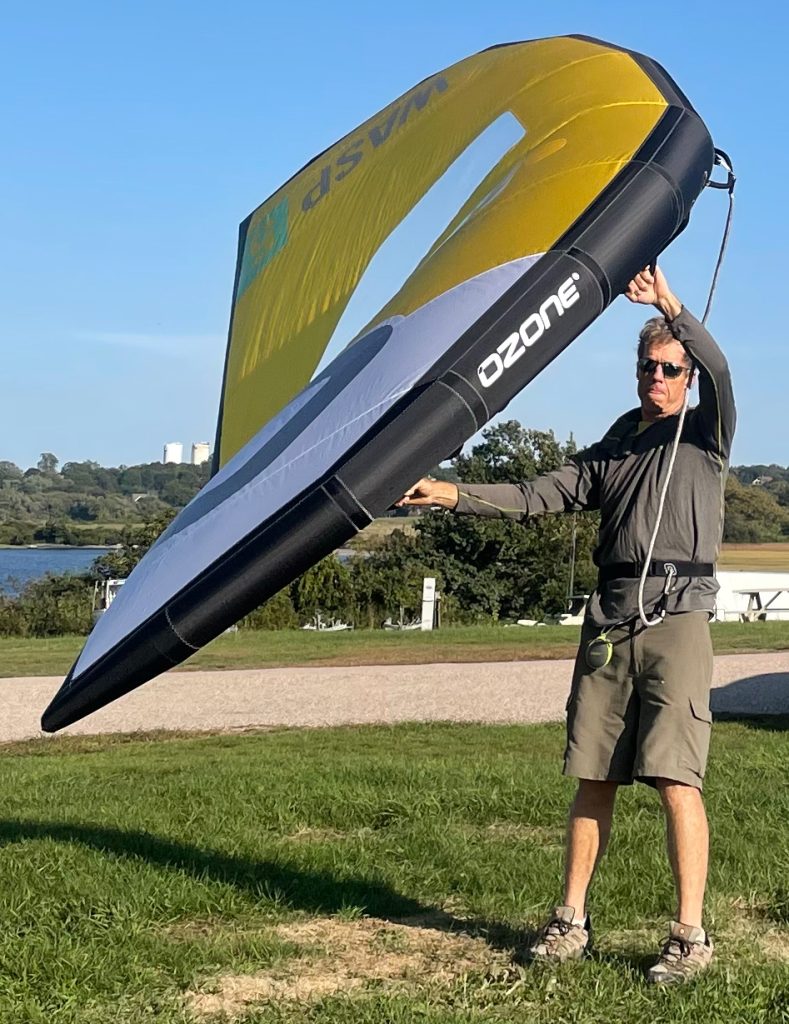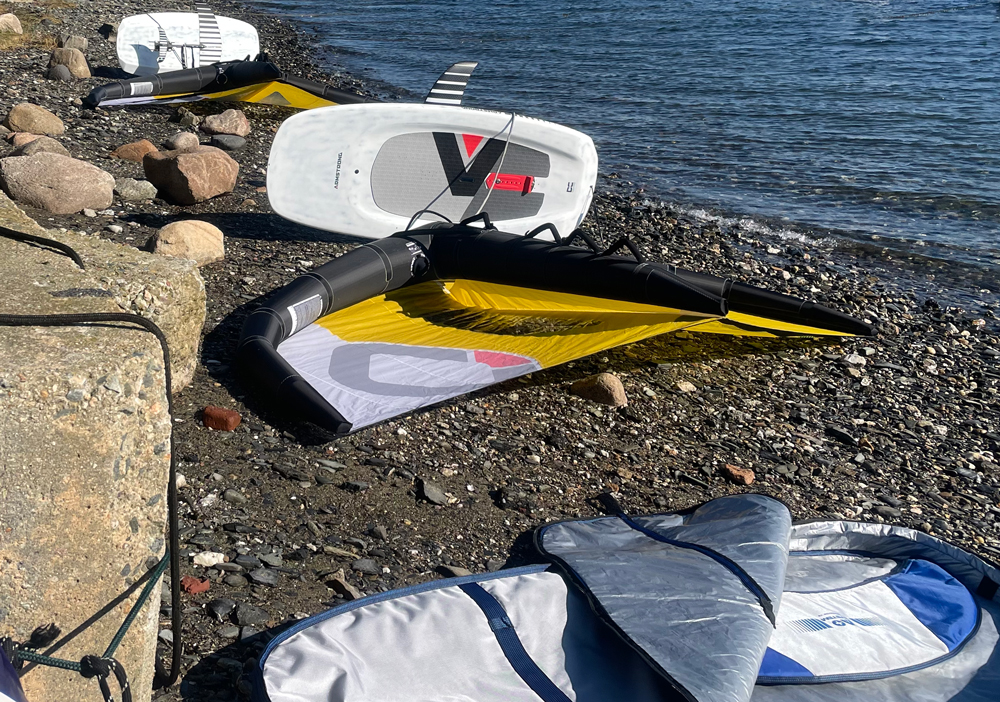In the fall of 2020, after the boats were put away for the winter, we went on several afternoon drives around Narragansett Bay as a much-needed escape from our home offices. One day, we spotted two people paddling small surfboards against a stiff northwest breeze, trying to get back to their launching area—and dragging what looked like giant butterflies behind them. “Wingfoiling,” Paul told me matter-of-factly, adding, “It’s taking over.”
Those two sailors were obviously just learning, but on other drives we spotted more advanced riders—and I became increasingly mesmerized. The sail area is supported by two inflated bladders, Paul explained; a big one along the leading edge, and a shorter one perpendicular to it. It seemed like a very appealing way to get out on the water and try this foiling thing.

But winter was already looming, and with a personal travel ban in place it was hardly the time to take up a new water sport. So I put away the dream, bracing for its inevitable return in February—when all of my craziest ideas seem most appealing—and fully expecting all thoughts of winging to fade away again by spring, as other sailing opportunities returned.
Instead, I spent several afternoons last summer jealously watching a few neighbors zoom around the outer harbor. The photo below was taken on a sparkling September day—and it’s the same guy we’d spotted paddling back to the beach, the previous October. From wing-flailing to buzzing the fleet in less than a year!
His enviable confidence renewed my interest, but unlike the Snipe there were no fleet loaners to try out. So a few weeks later (as soon as my final regatta of 2021 was over), I splurged on new gear. Within a month, I had my very first giggle-inducing flight.

And now that the season has ended, I’ve put together my top six lessons from climbing this very steep learning curve.
1. Invest in good equipment
I’ve written before about the benefits of buying better equipment than you think you “deserve.” Wingfoiling has developed very quickly, so instead of buying year-old technology I took Paul’s advice and ordered the latest gear. The very first time I flew my wing—standing in an open field, to minimize the variables—was only the second time I’d ever held one, but I could already appreciate how much more stable it was than the previous year’s model. I was also instantly addicted to the way every micro shift and puff altered the pull on my arms: I am mast and boom, as well as sheet and guy. And I loved having the wings of a butterfly.

2. Time on the water is invaluable
Taking those wings out on the water more than doubled the vector-variables. Instead of solid grass underfoot, I now had to balance on a board only half the length of my SUP. Again, Paul’s recommendation of a big floaty board (by wing standards, at least) meant that at least it wasn’t sinking underneath me. And it only took a few runs on my knees to figure out how to stand up—the first of several huge milestones.
3. Video is a great learning tool
While sailing and paddling skills definitely apply, winging requires a totally new set of instincts. Even the most subtle shifts and puffs change the wing’s tug and balance. And moving my front (or back) foot an inch in any direction could either help the board transition up onto the foils—or send me into a face plant. My brain could only absorb so many inputs while my hands and feet were active too, so it really helped to watch videos of others learning. What a luxury to reinforce what I’d felt on the board that afternoon with an evening lesson in the dry safety of our living room, analyzing how others had worked through the same challenges.
4. A partner makes it a lot more fun
Sharing the process with Paul is a real treat for many reasons. He already has two years of windsurf-foiling skills, so there’s a ready supply of advice for when I can’t quite master that next step. And, like doublehanded sailing, it’s just a lot more fun when you have a buddy to share both thrills and spills. We’d each whoop and holler when we saw the other rise out of the water—and then laugh at the inevitable wipeout, knowing that we’d be next.
5. Old dogs can learn new tricks, but it’s harder
Learning new skills is extremely humbling, and after a completely unexpected crash early on, I wondered if I was really up for all the effort required to master this new sport. I’m sure it’s not the last time I will wonder that… but what will keep me coming back is the simple joy of feeling wind vectors pulling me across the water, plus the ongoing challenge of learning to fly.
6. Mistakes are the best way to learn
Almost exactly a year to the day after watching those two newbies paddling their wings back upwind, we launched from the same beach in what turned out to be too much breeze for me—and I found myself paddling back upwind across the same puffy patch of water. Matching conditions to wing size is a major part of the learning curve in this very weather-dependent sport, and each mistake made me better able to assess from the beach which wing I should rig—or whether to come back another day.
On our final day of winging for this year, I got up on the foil twice for about ten seconds of controlled flight—as well as some uncontrolled giggling. It felt like excellent progress, and I look forward to continuing up the learning curve over the winter. Maybe, by the time September glistens again, you’ll even see me out buzzing around the harbor, in complete control.

Learn more
Here’s the YouTube channel I found most helpful. If you just want to understand “why” it’s so addicting, watch Rachael Miller’s video.
What I’m riding
- Armstrong FG Wing SUP Foilboard (6’4″ long)
- Armstrong A+ System Carving Freeride Foil Package CF2400 V2
- Ozone Wasp V2 Wing 5m (8-12 knots)
- Ozone Wasp V2 Wing 4m (12-16 knots)
What I’m wearing (water and air 55-65 degrees F)
- Zhik hydrophobic top
- Zhik titanium top
- Lightweight spray top
- 3mm Gill short-arm wetsuit (I’ve had this suit since 2002!)
- Zhik helmet
- Zhik lifejacket (soon to be replaced with their impact jacket)
- Showerspass socks
- Zhik boots
Love it, so much fun doing it together. And now coming attraction, “Warm Water”.
Yes indeed, looking forward to our next foiling adventure!
Carol, I recall from a previous video that you’re a push-ups person, but, still, for how long can your arms hold up when wing foiling? If, as it appears, you’re holding the wing against the pressure of the wind, what happens should your arms become exhausted or you suffer a muscle strain?
It doesn’t appear there’s much room to sit on the board and rest? I’m not being a downer; just curious.
Larry. thanks for the question. We were both really surprised by how little strain there is holding the wing. It’s very easy to depower by letting it “flap” (though it doesn’t actually make any noise) rather than pulling against it. And even before we get foiling, there’s not much forward force needed.
The biggest priority is actually aerobic fitness, so it’s good incentive to keep running/walking/paddling.
Thx for reading!
Great stuff Carol, thanks for sharing. Maybe the next adventure for the Halls…
Thanks JJ, it would be really fun to meet up on a (warm) beach somewhere!